Abstract
A high-performance electric motorcycle (HPEM) integrated charger-inverter (ICI) with an induction motor (IM) is proposed in this article. Typical components are shared in drive and charge modes, resulting in savings of weight, volume, and cost. A two-stage ICI for AC induction motor powertrain with power factor correction (PFC) and battery charger functions is considered. Despite high voltage ripple on the DC link, a high bandwidth nonlinear controller can reject such a drawback and adequately provide a constant current or constant voltage charging process. The simulation results of 7 kW ICI are provided to validate the effectiveness and feasibility of the proposed system. Finite element analysis (FEA) determines the torque and losses of IM in charging mode.
1. Introduction
In electric vehicles (EVs) application, driving range is one of most important criteria determining whether people will buy an EV. Both battery technology and fast charging infrastructure are thus hugely invested in by governments and private companies. AC charging stations require an on-board charger (OBC), while DC charging stations move charger power electronics, filters, and so on off board []. The charging power of a DC charging station can be much higher than that of an AC charging station with OBC regarding weight and volume constraints. In high-performance electric motorcycle (HPEM) application, weight and volume constraints are much more critical than in other type of EVs. Such vehicles in the market can only be installed with a low-power OBC []. This results in a long charge duration. Very few high-performance electric vehicles (HPEVs) have DC charging capability, thus they are less practical in countries where bulky and expensive DC charging stations are not well covered [].
Integrated charger-inverters (ICI) allow using power electronic components as an inverter in driving mode and can be reconfigured by relays and contactors to be used as a charger in charging mode. Several possibilities have been reviewed, including single-phase input, three-phase input, multi-machine, multi-phase machine, and so on [,,,,,,,,,,]. However, for motorcycle applications, only three-phase machines have been reasonably considered owing to their weights and volumes.
In the literature, EVs with several types of three-phase electric motors have been proposed, such as permanent magnet synchronous motors (PMSMs), switched-reluctance motors (SRMs), and induction motors (IMs) [,,]. PMSM offers high efficiency []. SRMs give cost-effective, but poor efficiency and high ripple torque [,]. However, most ICI have IMs. This is because of the IMs’ advantages, such as low maintenance requirements, reliability, and low cost [,].
To use the motor’s winding as an inductor for ICI, the motor’s torque must be investigated primarily during the charging process, resulting in low efficiency. For the three-phase ICI with a three-phase synchronous machine, special winding must be used to ensure that the average torque is zero []. To nullify the averaged torque, another solution is proposed without any additional component in [], where the four motors have EVs with a three-phase grid as an energy source. Each phase of the grid is connected directly to the neutral point of the motor. Therefore, the currents of each phase flow through the three windings at the same waveform (zero-sequence stator currents) and cancel the field of each other so that there is no torque production. The applicable motor can be either three-phase IMs or three-phase PMSM. This technique can be applied for the single three-phase motor with an extra leg of the inverter [] or the two three-phase motor without the extra leg [] with single-phase grid supply. However, these configurations have one main disadvantage, which is the pulsation current at double grid frequency of battery due to the use of a single-phase grid. Another work is proposed in [], where a single-phase quasi-Z-source rectifier with an active filter is used. With the active filter to absorb the double grid frequency ripple, the dc-link capacitor, inductor, and capacitor of the quasi-Z-source converter can be reduced to gain a low weight and volume benefit. However, this converter requires a sophisticated controller, especially to control the active filter.
To demonstrate that average torque during the charging process is null, several works proposed it mathematically. Recently, finite element results are used to validate the average torque of PMSMs []. However, such an analysis is rare for IMs.
This work focuses on a 7 kW ICI for HPEM. Common components are shared in drive and charge modes. Weight, volume, and cost saving can be expected. The charging power of 7 kW is more usable in the real-world situation, where a 10–14 kWh battery pack can be fully charged in approximately 2 h. Moreover, 50 km of range can be topped up within 20 min.
A two-stage ICI for AC induction machine (IM) powertrain with power factor correction (PFC) as well as battery charger functions are investigated in this work. ICI topology and control algorithm are verified using circuit simulations. Finite element analysis (FEA) determines the torque and losses of IM in charge mode. Finally, simulations are conducted and some results are shown in the last section.
2. Integrated Charger-Inverter
2.1. Topology
The proposed ICI is used for a high-performance electric motorcycle (HPEM). The HPEM is equipped with a 100 kW three-phase IM powertrain driven by a three-phase inverter. In charge mode, six power switches from a three-phase full-bridge inverter and IM’s phase windings are reconfigured and reused as a line filter, as well as a single-phase bridgeless rectifier with power factor correction (PFC) and a bi-directional buck-boost converter for the battery charger.
Figure 1 shows the topology of the electric powertrain in drive mode. It is a conventional three-phase full bridge inverter. A battery pack is directly connected to the DC bus.
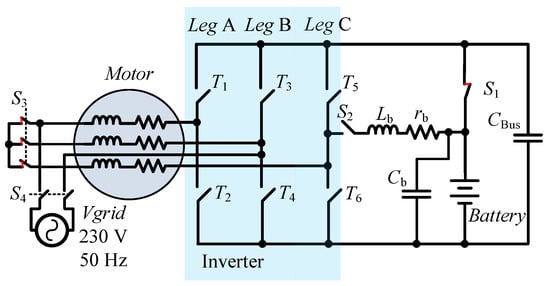
Figure 1.
Integrated charger-inverter (ICI) topology in drive mode.
In charge mode, S1, S2, S3, and S4 help reconfigure the topology, as shown in Figure 2. Phase-A winding of IM is used as a line filter. Two half-bridge legs (T1, T2, T3, and T4) are controlled as an AC/DC PFC rectifier. Another half-bridge leg (T5 and T6) functions as bi-directional buck-boost DC/DC converter connected to the battery pack through an additional inductor.
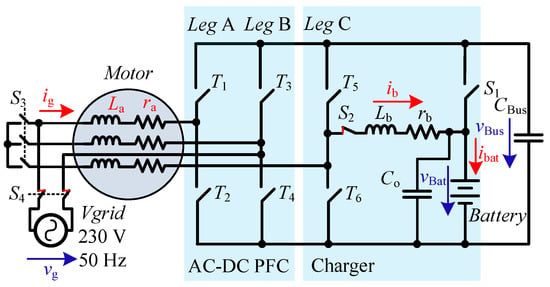
Figure 2.
ICI topology in charge mode. PFC, power factor correction.
2.2. Control Algorithm
When the converter system operates in charging mode and supposes that all devices are ideal except inductors , which contain parasitic resistances (), the system can be expressed in the averaged model as follows:
where and are duty cycles corresponding to the switch turn-on time during the switching period for the PFC and charger, respectively. The voltages and are the grid and output voltage, where is the battery voltage. and are the grid and battery currents, respectively.
In this article, we consider only the AC-DC PFC converter and battery charger; therefore, control of inverter in driving mode is not considered; it can be found in another article.
PFC rectifier control is done in a traditional way, where the cascade control method is used. There are two control loops: inner-current loop and outer-voltage loop, as shown in Figure 3.
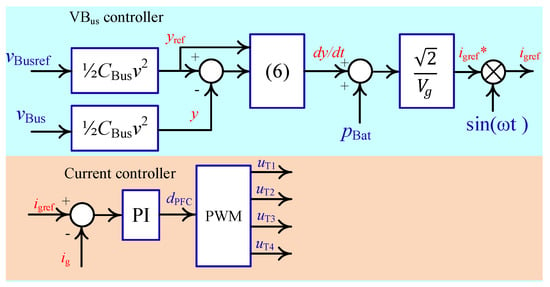
Figure 3.
PFC control block diagram.
Battery charger control is done using constant current (CC) and constant voltage (CV) modes []. These modes can be easily defined using a relay with a hysteresis band . When is too far from , the charger charges the battery in CC mode, and otherwise in CV mode. The output from the hysteresis relay is fed into the mode selection block to define the current reference for the current-control loop. Like for PFC rectifier control, two control loops are used, where an indirect-sliding mode control is used for the inner-current loop []; a PI controller is for the outer-voltage loop, as shown in Figure 4. Note that for the CC mode depends on a specification of battery, whereas the PI controller’s parameters and are chosen to make the system stable.
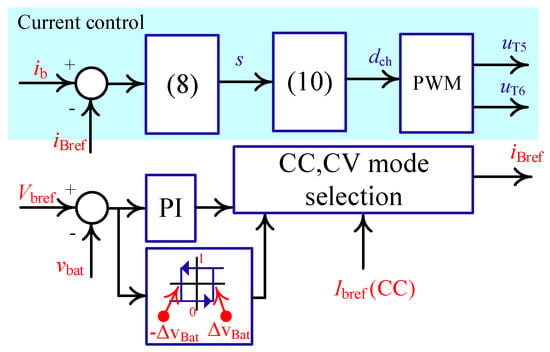
Figure 4.
Charger control block diagram. CC, constant current; CV, constant voltage.
To control the output voltage, and stored energy in are considered []. Then, it can be expressed as follows:
where is the input power drawn from the grid and is the load power.
Therefore, the following control law is used to control constant.
The control parameters and can be determined referring to a damping factor and angular frequency of the standard second-order system , so the controlled system is stable.
The input power is the power needed for load, and it can be used as a reference for the input-current loop of the PFC. The current reference can be obtained using the peak current value, corresponding to , which is nearly a constant multiple of a unit-sinusoidal waveform. Then, it is fed to a PI controller to govern the input current to be a sinusoidal shape and in phase to the grid voltage. The PI’s parameters are determined using a phase margin in a Bode diagram.
For the charging control, a nonlinear control, an indirect-sliding mode is chosen. This controller must be fast to mitigate fluctuation from both and circuit-parameter uncertainty. For a controller based on linear analysis, linearization may be used to obtain a model for design purposes. Instead, sliding mode control can use a nonlinear model []. For the constant current control, it governs as follows:
with
Applying the time derivative result of (8), and then replacing it in (9), we can find for .
When the controller controls the system, its pole can be fixed by the value of and , e.g., , where is the switching frequency.
3. Component Sizing
According to the topology shown in Figure 2, there are several capacitors and inductors. Their parameter must be carefully selected to suit their needs. The following sections determine their critical values based on the given specifications.
3.1. Inductors
In the PFC rectifier, only one inductor is usually placed in the circuit. Its minimum value is as follows []:
where is the peak input voltage, is the output power, and is the switching frequency. For the charger, the inductor can be chosen based on the maximum allowable ripple current , e.g., 2% []:
3.2. Capacitors
In the PFC rectifier without an active filter, only one capacitor is usually placed in the DC link. Its minimum capacitance can be computed as in (13) [].
where is the grid frequency; is the peak-to-peak ripple voltage around the desired output voltage , e.g., = 25%, according to the parameters given in Table 1; and has a minimum of 557 μF for 7 kW power requirement compared with 400–600 μF found in conventional OEM HEV/EV 100 kW inverters without an ICI feature. However, the ripple voltage does not cause any problem to the quality of charging current thanks to the high-band width nonlinear current controller; the controller rejects the ripple effect. For the capacitor across the battery , it is used to absorb the ripple current of the battery current. The maximum ripple voltage , e.g., 1% can be used to determine the value of as follows []:

Table 1.
On-board charger (OBC) parameters.
3.3. Specific Power Comparison
Table 1 shows the OBC parameters from articles and OEM manufacturers. Specific weight and power density can be varied from 0.41 to 1.1 kW/kg and from 0.61 to 2 kW/L. The OBC cost in 2014 is approximately 83 USD/kW.
Table 2 shows the estimated weight, volume, and cost of the proposed 7 kW integrated charger-inverter. It must be noted that the main components, shown in Table 2, are added to a conventional traction inverter so that the whole system can function as a charger. The main traction inverter itself is considered as an existing component in the vehicle and will contribute to achieve the ICI’s feature without any additional weight, volume, and cost to the system. As a result, the additional components of the proposed ICI will add approximately 1.19 kg, 0.64 l, and 75 USD to the system. The specific weight, power density, and cost per kW can be computed as 5.88 kW/kg, 10.93 kW/L, and 10.71 USD/kW, respectively. These values are much better than a conventional OBC.

Table 2.
Additional components of the proposed integrated charger-inverter 7 kW.
Compared with the 6.6 kW integrated charger-inverter found in [], it will add weight of 1.6 kg to the conventional traction inverter, which is equivalent to 4 kW/kg specific weight, as shown in Table 3. This value is quite similar to the one of the proposed ICI.

Table 3.
Integrated charger-inverter (ICI) parameters.
4. Simulation Results
4.1. Charge Simulations
Simulations were conducted in PSIM and MATLAB/Simulink environment using the parameters given in Table 4 and Table 5. Circuit components were simulated in PSIM and coupled with control algorithms running in MATLAB/Simulink.

Table 4.
Converter parameters. PFC, power factor correction.

Table 5.
Control parameters.
Figure 5 shows the results in steady state for = 7 kW. The output voltage contains ripple voltage of about 96.5 V, which is 24% of the reference voltage.
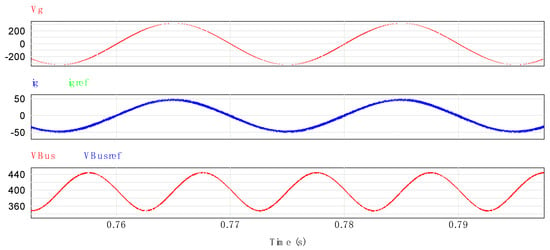
Figure 5.
DC link voltage without active filter for .
In Figure 6, one cycle of the grid voltage and grid current is illustrated. is multiplied by 4 to increase its amplitude; it is close to the sinusoidal wave; therefore, the system draws power from the grid with a high power factor. It can be seen from Figure 7 that PF is higher than 0.8 at the light-load condition. It reaches 0.998 when the output power is higher than 6 kW.
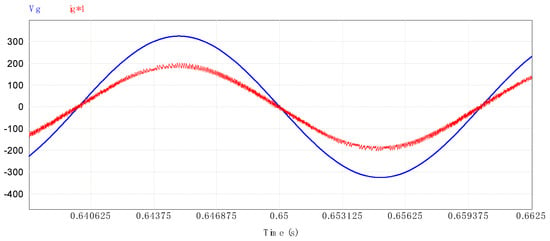
Figure 6.
Input current waveform for .
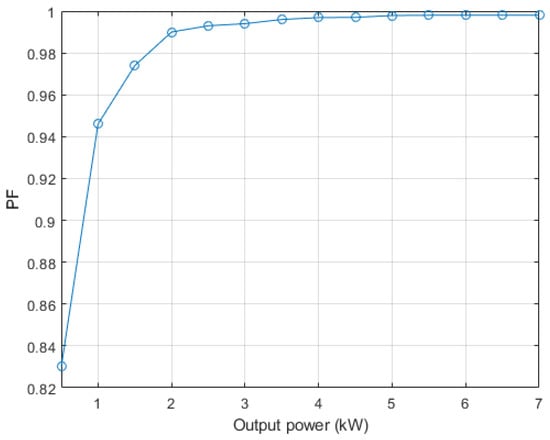
Figure 7.
Power factor (PF) for different levels of output power.
Figure 5 shows results in steady state for . The output voltage contains ripple voltage of about 96.5 V, which is 24% of the reference voltage, and the grid current is illustrated, which is multiplied by 4 to increase its amplitude; it is close to the sinusoidal wave; therefore, the system draws power from the grid with a high power factor. It can be seen from Figure 7 that PF is higher than 0.8 at the light-load condition. It reaches 0.998 when the output power is higher than 6 kW. Figure 8, Figure 9 and Figure 10 show the responses of the system when is changed slightly from 1.5 kW to 7 kW. The rate of current reference is limited to four times less than to ensure that the system can be adequately worked without any overshoot of the battery current, as shown in Figure 8. The waveform of battery current shows that the high-band width nonlinear current controller can effectively reject the ripple effect from .
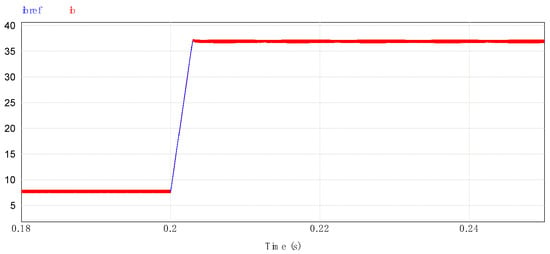
Figure 8.
Battery current waveform for .
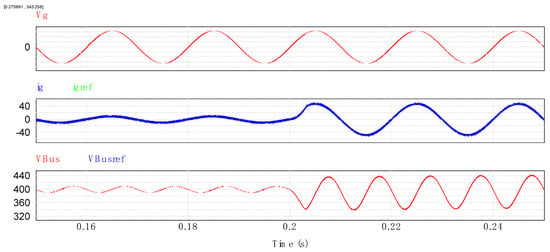
Figure 9.
DC link voltage without an active filter .
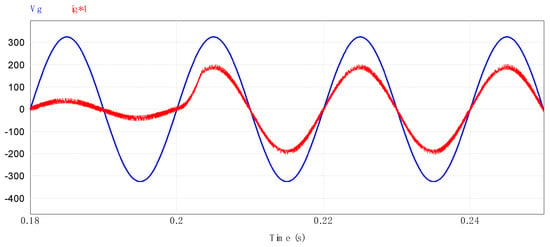
Figure 10.
Input current waveform for .
From the results, the output voltage quickly returns to its reference after the change of the battery current, while the grid current is in good shape. A monotonic relationship between and the grid current can be observed.
4.2. Electromagnetic Torque
In charge mode, one motor winding is reused as a line filter inductor, as shown in Figure 2. The input current passing through the winding may generate torque. While simple equations can be computed to quantify the electromagnetic torque, finite element analysis (FEA) gives more information on flux distribution and losses in the machine.
The first simulation in 2D FEA is realized with the hypothesis of sinusoidal current input of 32 Arms. Figure 11 shows the electromagnetic torque stabilized in 100 ms, where the average value is only 7.7 mNm. This torque level cannot move the electric motorcycle. The losses calculated in 2D FEA without taking into account the end winding are presented in Figure 12. Their values are very small. Thermal calculation is not necessary for this motor.

Figure 11.
Electromagnetic torque with 32 A sinusoidal current input.
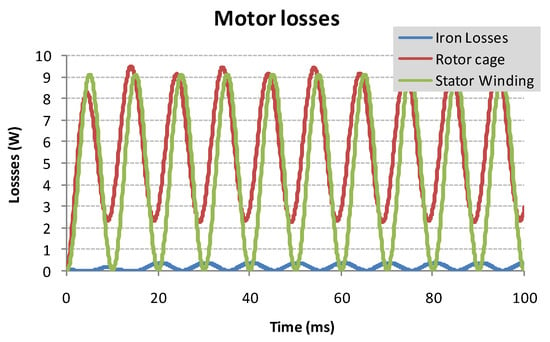
Figure 12.
Losses of induction motor in 2D finite element analysis (FEA).
The second modeling of the machine in 2D FEA is done in a more realistic case. The harmonic 5 and 7 are taken into account in the input current. The results are shown in Figure 13, Figure 14 and Figure 15. The electromagnetic torque is stabilized for eight times longer than the first simulation with sinusoidal current input. Even with adding the current harmonics 5 and 7, the average electromagnetic steady-state torque is only 16 mNm, and the losses do not impact the thermal behavior of the machine.
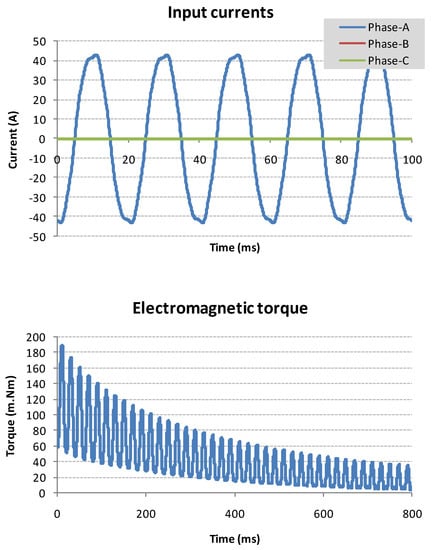
Figure 13.
Electromagnetic torque with 32 A harmonic current.
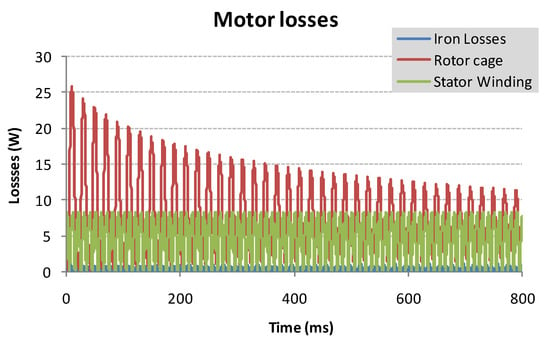
Figure 14.
Losses in 2D FEA with harmonic current.
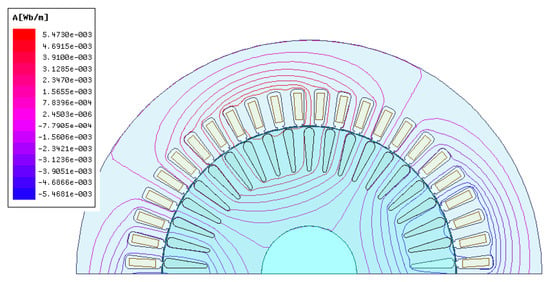
Figure 15.
Flux circulation of induction motor (IM) in charge mode.
5. Conclusions
An integrated charger-inverter (ICI) with an induction motor for high-performance electric motorcycle is proposed. To reduce the weight, volume, and cost, the main components are shared in drive and charge modes. The phase-A winding is used as an inductor for PFC using the first two legs of the three-phase inverter, while another leg is utilized to act as a charger with an additional inductor. The high bandwidth nonlinear controller rejects the double frequency ripple on the dc-link and allows the charger to adequately provide a constant current or constant voltage charging. The simulation results of 7 kW system validate the proposed system. Finite element analysis (FEA) determines the torque and losses of IM in charging mode and reveals that the torque productions are very small. It is notable to move the rotor. In addition, losses of the motor from the FEA results are low. Therefore, the proposed system can be implemented further.
Author Contributions
This article presents the collective work of all authors (V.T.T., M.P., and S.K.). All authors have read and agreed to the published version of the manuscript.
Funding
This work was funded in part by Hanoi University of Science and Technology (HUST) and King Mongkut University of Technology north of Bangkok, Thailand (grant number KMUTNB-63-KNOW-035).
Conflicts of Interest
The authors declare no conflict of interest.
References
- Drobnic, K.; Grandi, G.; Hammami, M.; Mandrioli, R.; Ricco, M.; Viatkin, A.; Vujacic, M. An Output Ripple-Free Fast Charger for Electric Vehicles Based on Grid-Tied Modular Three-Phase Interleaved Converters. IEEE Trans. Ind. Appl. 2019, 55, 6102–6114. [Google Scholar] [CrossRef]
- Patil, D.; Agarwal, V. Compact Onboard Single-Phase EV Battery Charger with Novel Low-Frequency Ripple Compensator and Optimum Filter Design. IEEE Trans. Ind. Appl. 2016, 65, 1948–1956. [Google Scholar] [CrossRef]
- Shi, C.; Tang, Y.; Khaligh, A. A Three-Phase Integrated Onboard Charger for Plug-In Electric Vehicles. IEEE Trans. Power Electron. 2018, 33, 4716–4725. [Google Scholar] [CrossRef]
- Hatti, N.; Nuilers, S.; Chayopitak, N.; Somsiri, P. An integrated battery charger configuration for SRM drive in electric motorcycles. IEEJ Trans. Electr. Electron. Eng. 2018, 13, 295–302. [Google Scholar] [CrossRef]
- Subotic, I.; Bodo, N.; Levi, E. Single-Phase On-Board Integrated Battery Chargers for EVs Based on Multiphase Machines. IEEE Trans. Power Electron. 2016, 31, 6511–6523. [Google Scholar] [CrossRef]
- Shi, C.; Tang, Y.; Khaligh, A. A Single-Phase Integrated Onboard Battery Charger Using Propulsion System for Plug-in Electric Vehicles. IEEE Trans. Veh. Technol. 2017, 66, 10899–10910. [Google Scholar] [CrossRef]
- Cheng, H.; Wang, Z.; Yang, S.; Huang, J.; Ge, X. An Integrated SRM Powertrain Topology for Plug-In Hybrid Electric Vehicles with Multiple Driving and Onboard Charging Capabilities. IEEE Trans. Transp. Electrif. 2020, 6, 578–591. [Google Scholar] [CrossRef]
- Bodo, N.; Levi, E.; Subotic, I.; Espina, J.; Empringham, L.; Johnson, C.M. Efficiency Evaluation of Fully Integrated On-Board EV Battery Chargers with Nine-Phase Machines. IEEE Trans. Energy Convers. 2017, 32, 257–266. [Google Scholar] [CrossRef]
- Metwly, M.Y.; Abdel-Majeed, M.S.; Abdel-Khalik, A.S.; Hamdy, R.A.; Hamad, M.S.; Ahmed, S. A Review of Integrated On-Board EV Battery Chargers: Advanced Topologies, Recent Developments and Optimal Selection of FSCW Slot/Pole Combination. IEEE Access 2020, 8, 85216–85242. [Google Scholar] [CrossRef]
- Kataoka, R.; Shichi, A.; Yamada, H.; Iwafune, Y.; Ogimoto, K. Comparison of the Economic and Environmental Performance of V2H and Residential Stationary Battery: Development of a Multi-Objective Optimization Method for Homes of EV Owners. World Electr. Veh. J. 2019, 10, 78. [Google Scholar] [CrossRef]
- Subotic, I.; Jones, M.; Levi, E. A fast on-board integrated battery charger for four-motor EVs. In Proceedings of the 2014 International Conference on Electrical Machines (ICEM), Berlin, Germany, 2–5 September 2014; pp. 2066–2072. [Google Scholar]
- Thimmesch, D. An SCR inverter with an integral battery charger for electric vehicles. IEEE Trans. Ind. Appl. 1985, IA-21, 1023–1029. [Google Scholar] [CrossRef]
- Tang, L.; Su, G.-J. Control scheme optimization for a low-cost, digitally-controlled charger for plug-in hybrid electric vehicles. In Proceedings of the 2010 IEEE Energy Conversion Congress and Exposition, Atlanta, GA, USA, 12–16 September 2010; pp. 3604–3610. [Google Scholar]
- Matsuhashi, D.; Matsuo, K.; Okitsu, T.; Ashikaga, T.; Mizuno, T. Comparison study of various motors for EVs and the potentiality of a ferrite magnet motor. IEEJ J. Ind. Appl. 2015, 4, 173–179. [Google Scholar] [CrossRef][Green Version]
- Tuan, V.T.; Kreuawan, S.; Somsiri, P.; Tungpimolrut, K.; Huy, P.N. Switched Reluctance Motor and Induction Machine for E-Scooter Based on Driving Cycles Design Comparisons. IEEJ Trans. Electr. Electron. Eng. 2020, 15, 931–938. [Google Scholar] [CrossRef]
- Vosswinkel, M.; Lohner, A.; Platte, V.; Hirche, T. Design, Production, and Verification of a Switched-Reluctance Wheel Hub Drive Train for Battery Electric Vehicles. World Electr. Veh. J. 2019, 10, 82. [Google Scholar] [CrossRef]
- Na, T.; Zhang, Q.; Tang, J.; Wang, J. Active power filter for single-phase Quasi-Z-source integrated on-board charger. CPSS Trans. Power Electron. Appl. 2018, 3, 197–201. [Google Scholar] [CrossRef]
- Xiao, Y.; Liu, C.; Yu, F. An Effective Charging-Torque Elimination Method for Six-Phase Integrated On-Board EV Chargers. IEEE Trans. Power Electron. 2020, 35, 2776–2786. [Google Scholar] [CrossRef]
- Gavagsaz-Ghoachani, R.; Saublet, L.; Phattanasak, M.; Martin, J.; Nahid-mobarakeh, B.; Pierfederici, S. Active stabilisation design of DC–DC converters with constant power load using a sampled discrete-time model: Stability analysis and experimental verification. IET Power Electron. 2018, 11, 1519–1528. [Google Scholar] [CrossRef]
- Gavagsaz-Ghoachani, R.; Phattanasak, M.; Martin, J.; Nahid-Mobarakeh, B.; Pierfederici, S. A Fixed-Frequency Optimization of PWM Current Controller—Modeling and Design of Control Parameters. IEEE Trans. Transp. Electrif. 2018, 4, 671–683. [Google Scholar] [CrossRef]
- Das, P.; Pahlevaninezhad, M.; Moschopoulos, G. Analysis and Design of a New AC–DC Single-Stage Full-Bridge PWM Converter with Two Controllers. IEEE Trans. Ind. Electron. 2013, 60, 4930–4946. [Google Scholar] [CrossRef]
- Ferrieux, J.P.; Forest, F. Alimentations à Découpage Convertisseurs à Résonance, 3rd ed.; Dunod: Malakoff, France, 2006. [Google Scholar]
- Nussbaumer, T.; Raggl, K.; Kolar, J.W. Design Guidelines for Interleaved Single-Phase Boost PFC Circuits. IEEE Trans. Ind. Electron. 2009, 56, 2559–2573. [Google Scholar] [CrossRef]
- Shenai, K. WBG Power Converters for Hybrid & EV Applications. Auto Tech. Rev. 2016, 5, 42–47. [Google Scholar]
- Robert, E.; Dragan, M.; Khurram, A.; David, J.; Daniel, F.; Hyeokjin, K.; Usama, A.; Jianglin, Z.; Kraig, O.; Brandon, P.; et al. A Disruptive Approach to Electric Vehicle Power Electronics Final Report; Univ. of Colorado: Boulder, CO, USA, 2017. [Google Scholar]
Publisher’s Note: MDPI stays neutral with regard to jurisdictional claims in published maps and institutional affiliations. |
© 2021 by the authors. Licensee MDPI, Basel, Switzerland. This article is an open access article distributed under the terms and conditions of the Creative Commons Attribution (CC BY) license (http://creativecommons.org/licenses/by/4.0/).